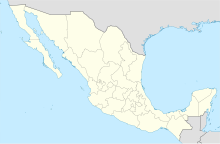
The Summitville mine was a gold mining site in the United States, located in Rio Grande County, Colorado 25 miles (40 km) south of Del Norte. It is remembered for the environmental damage caused in the 1980s by the leakage of mining by-products into local waterways and then the Alamosa River.

Agnico Eagle Mines Limited is a Canadian-based gold producer with operations in Canada, Finland, Australia and Mexico and exploration and development activities extending to the United States. Agnico Eagle has full exposure to higher gold prices consistent with its policy of no-forward gold sales. It has paid a cash dividend every year since 1983.

Eldorado Gold Corporation is a Canadian company that owns and operates gold mines in Turkey, Greece and Canada. Since its merger with European Goldfields in 2011 the company has been pursuing the development of the Skouries mine, Olympias mine and Stratoni mine in Greece. The company previously developed and operated gold mines in China, Brazil and Mexico. Headquartered in Vancouver and listed on the Toronto and New York Stock Exchanges, Eldorado Gold has developed and operated assets from several merged companies HRC Developments Corporation, Afcan Mining Corporation, Sino Gold Mining, Brazauro Resources, Integra Gold, as well as European Goldfields.

The National Copper Corporation of Chile, abbreviated as Codelco, is a Chilean state-owned copper mining company. It was formed in 1976 from foreign-owned copper companies that were nationalised in 1971.
Newmont Corporation is an American gold mining company based in Greenwood Village, Colorado. It is the world's largest gold mining corporation. Incorporated in 1921, it owns gold mines in the United States, Canada, Mexico, the Dominican Republic, Australia, Ghana, Argentina, Peru, and Suriname. In addition to gold, Newmont mines copper, silver, zinc and lead.

Gold mining is the extraction of gold by mining.
Goldcorp Inc. was a gold production company headquartered in Vancouver, British Columbia, Canada. The company stood among the largest gold producers in the world, employed about 15,800 people worldwide, engaged in gold mining and related activities including exploration, extraction, processing and reclamation. Goldcorp’s operating assets included eleven mines in North and South America.
Kinross Gold Corporation is a Canadian-based gold and silver mining company founded in 1993 and headquartered in Toronto, Ontario, Canada. Kinross currently operates six active gold mines, and was ranked fifth of the "10 Top Gold-mining Companies" of 2019 by InvestingNews. The company's mines are located in Brazil, Mauritania, and the United States. It trades under the KGC ticker in the New York Stock Exchange, and under K in the Toronto Stock Exchange.

Silver mining is the extraction of silver by mining. Silver is a precious metal and holds high economic value. Because silver is often found in intimate combination with other metals, its extraction requires the use of complex technologies. In 2008, approximately 25,900 metric tons of silver were consumed worldwide, most of which came from mining. Silver mining has a variety of effects on the environment, humans, and animals.

In the United States, gold mining has taken place continually since the discovery of gold at the Reed farm in North Carolina in 1799. The first documented occurrence of gold was in Virginia in 1782. Some minor gold production took place in North Carolina as early as 1793, but created no excitement. The discovery on the Reed farm in 1799 which was identified as gold in 1802 and subsequently mined marked the first commercial production.
Pan American Silver Corporation is a mining company based in Canada with operations in Latin America. The company has mines and other projects in Mexico, Peru, Bolivia, and Argentina.

Romania ranks tenth in the world in terms of the diversity of minerals produced in the country. Around 60 different minerals are currently produced in Romania. The richest mineral deposits in the country are halite.
Coeur Mining, Inc. is a precious metals mining company listed on the New York Stock exchange. It operates five mines located in North America. Coeur employs 2,200 people and in 2012 it was the world's 9th largest silver producer. In 2013 the company changed its name to Coeur Mining, Inc. from Coeur d'Alene Mines and moved its head office to Chicago, Illinois from Coeur d'Alene, Idaho.

Goldstrike is a gold mine in Eureka County in north-eastern Nevada. It is located on the Carlin Trend, a prolific gold mining district. It is owned and operated by Barrick Gold. Since Barrick acquired Goldstrike in 1986, until 2018 it produced 44.4 million ounces of gold.

The Cripple Creek & Victor Gold Mine, formerly and historically the Cresson Mine, is an active gold mine located near the town of Victor, in the Cripple Creek mining district in the US state of Colorado. The richest gold mine in Colorado history, it is the only remaining significant producer of gold in the state, and produced 322,000 troy ounces of gold in 2019, and reported 3.45 million troy ounces of Proven and Probable Reserves as at December 31, 2019. It was owned and operated by AngloGold Ashanti through its subsidiary, the Cripple Creek & Victor Gold Mining Company (CC&V), until 2015, when it sold the mine to Newmont.
New Gold Inc. is a Canadian mining company that owns and operates the New Afton gold-silver-copper mine in British Columbia and the Rainy River gold-silver mine in Ontario, Canada. Through a Mexican subsidiary company, they also own the Cerro San Pedro gold-silver mine in San Luis Potosí, Mexico, which ceased operation in 2017. While New Gold was founded in 1980 for the purposes of mineral exploration, the company became a mine operator with its merger of Peak Gold and Metallica Resources in 2008. A fourth company, Western Goldfields, joined in 2009. Together they operated the Peak mine in Australia and Mesquite Mine in California but sold both in 2018. Headquartered in Toronto, shares of the company are traded on the Toronto Stock Exchange and NYSE American.

First Majestic Silver Corp. is a Canadian silver-mining company that operates in Mexico and the United States. It has four producing mines under its control: San Dimas Silver/Gold Mine, Santa Elena Silver/Gold Mine, La Encantada Silver Mine, and Jerritt Canyon Gold Mine. First Majestic also produces and sells its own bullion rounds and bars.

Alamos Gold Inc. ("Alamos") is a Canadian multinational gold producer, headquartered in Toronto, Canada. Alamos operates three mines across North America, and has six further projects in development.

The Kubi gold mine is an abandoned open pit mine located 8 kilometres (5.0 mi) northeast of Dunkwa-on-Offin and 22 kilometres (14 mi) south of Obuasi, in Central Region, southern Ghana. It is 180 kilometres (110 mi) northwest of the national capital, Accra.
El Chanate is a former gold mine in Sonora, Mexico owned by Alamos Gold.













